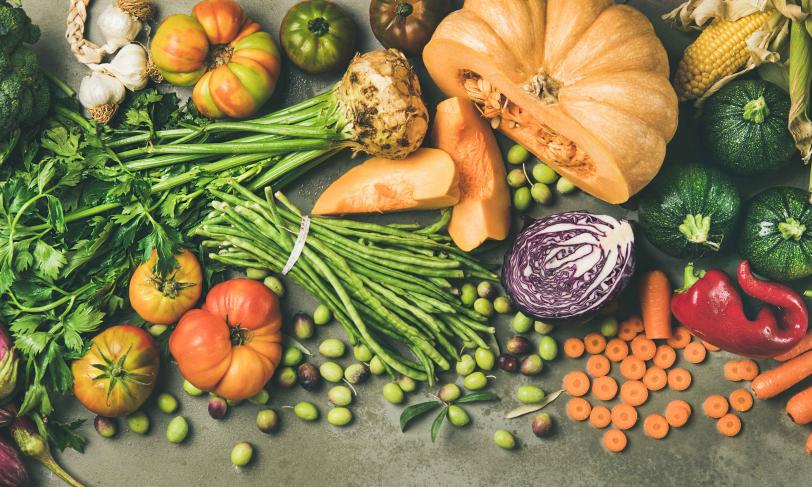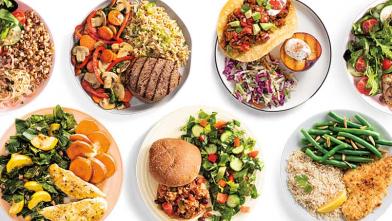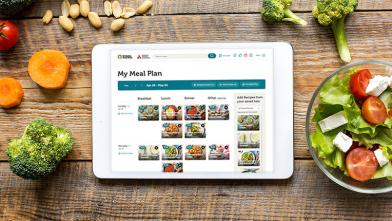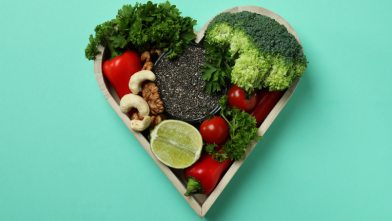You’ve probably heard since you were a kid that you should eat your vegetables. Well, there are a lot of good reasons why everyone should be sure to include vegetables as part of their meals, especially people with diabetes.
Vegetables are powerhouses of nutrition that play a role in lowering the risk for or in managing some diseases. Vegetables can help manage blood pressure, lower your risk of heart disease, prevent some cancers, promote gut health, fight infections, and manage weight. They also provide energy and nutrients that are important for brain health.
Non-Starchy Vegetables
The American Diabetes Association’s visual guide for creating healthy meals, the Diabetes Plate, focuses on non-starchy vegetables. The largest section of the nine-inch plate (half of it) is for them! This is because they are low in calories, low in carbohydrates (carbs), and have vitamins and minerals. Non-starchy vegetables are also a source of fiber. Including higher fiber foods is helpful in slowing the digestion of carb foods, which means there is less chance of the carbs spiking your blood glucose (blood sugar). A serving of non-starchy vegetables is ½ cup cooked or 1 cup raw. One serving has 5 grams of carbs or less.
There are many non-starchy vegetables to choose from, including:
| Artichoke | Asparagus | Baby corn |
| Bamboo shoots | Bean sprouts | Beans (green, wax, Italian) |
| Beets | Bok Choy | Broccoli |
| Brussels sprouts | Cabbage | Carrots |
| Cauliflower | Chayote | Coleslaw (no dressing) |
| Cucumber | Eggplant | Gourds (bitter, bottle, lufta, bitter melon) |
| Green onions/scallions | Greens (collard, kale, mustard, turnip, hearts of palm) | Jicama |
| Kohlrabi | Leeks | Mung bean sprouts |
| Mushrooms, all kinds | Okra | Onions |
| Oriental radish or daikon | Pea pods | Peppers |
| Radishes | Rutabaga | Sauerkraut |
| Soybean sprouts | Spinach | Squash (summer, crookneck, zucchini) |
| Sugar snap peas | Swiss chard | Tomato |
| Tomato/vegetable juice | Turnips | Water chestnuts |
| Yard long beans |
Starchy Vegetables
Starchy vegetables also have vitamins, minerals, and fiber, but have more carbs than non-starchy vegetables. One serving has 15 grams of carbs and their serving sizes can range from 1/3 cup to 1 cup. Even though starchy vegetables are higher in carbs, it doesn’t mean you shouldn’t eat them in your eating plan. They fit in the “quality carb” section of the Diabetes Plate, which fills ¼ of the plate.
There are several starchy vegetables you can choose from. Make sure to check the serving size and the way the food is prepared for a 15 gram carb choice.
| Corn on the cob (1/2 cob) | Hominy (3/4 cup) | Mixed vegetables with corn or peas (1 cup) |
| Parsnips (1/2 cup) | Peas, green (1/2 cup) | Potato, baked French fries (1 cup or 2 ounces) |
| Potato, baked with skin (1/4 large or 3 ounces) | Potato, boiled (1/2 cup or 1/2 medium, 3 ounces) | Succotash (1/2 cup) |
| Winter squash, acorn or butternut (1 cup) | Yam, sweet potato, plain (1/2 cup) |
Beans, peas, and lentils are plant-based proteins and starchy vegetables. The following have 15 grams of carbs and count as one serving of lean protein:
- Baked beans (1/3 cup)
- Cooked beans, black, garbanzo, kidney, lima, navy, pinto, white (1/3 cup)
- Cooked lentils, brown, yellow, or green (1/4 cup)
- Peas, black-eyed or split (1/2 cup)
- Refried beans, canned (1/3 cup)
Get Started
Adding more vegetables to your plate has many benefits ranging from getting more vitamins and minerals to having more food choices to help you feel full and satisfied. Review the list of veggies in this blog and try a new one to see if you might like it!. For example, have you ever tried roasted, air fried, or steamed radishes? While raw radishes have a bitter taste, cooked radishes lose the bitterness and can even be used instead of potatoes, cutting out the carbs.
Don’t forget to sign up for Diabetes Food Hub’s e-newsletter for monthly diabetes-friendly ideas and recipes using your favorite veggies!








